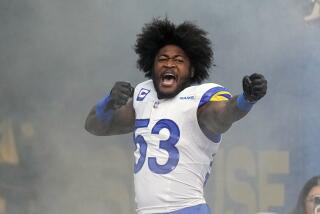Bill Comes Due for Rams
These are strange days for the Rams. They need a middle linebacker, they spend $5.4 million for one. They need a defensive end, they peel off another $3.75 million. They need a wide receiver, they fly in Hassan Jones to see if, maybe, they can make another purchase.
Money--it’s the new cure for all the evils plaguing the Rams in the 1990s.
If only they’d thought of it in 1987, when they refused to pay the best running back in the league like the best running back in the league, resulting in Eric Dickerson’s end run to Indianapolis and nobody living happily ever after.
Penny-wise then, they are still making payments on the deal more than five years later.
Charles White and Greg Bell were recycled stopgaps, nothing more.
Curt Warner proved to be much less than that.
Gaston Green is playing for his third organization in four years.
Cleveland Gary is averaging about a fumble every 100 yards, Robert Delpino is backing up Rod Bernstine in Denver and if the Rams’ season were to start today, David Lang, former last-round draft choice, would very likely be lining up as first-team tailback.
The Rams need a running back, perhaps never more so than now. As New Rams, they have whipped out the checkbook, poised to scribble out another seven figures, but--irony of ironies--there’s no one out there to buy.
No, the running back the Rams desire presently attends classes at the University of Georgia and can be had this Sunday by simply exercising one’s inalienable right to draft.
But the Rams draft 10th, and Garrison Hearst won’t last past the fourth pick. He is targeted for Phoenix, after New England and Seattle parcel out the quarterbacks, Drew Bledsoe and Rick Mirer, and the New York Jets select linebacker Marvin Jones.
Hearst has been called the next Barry Sanders. Knox likens him to Thurman Thomas and Emmitt Smith, and his eyes glimmer at the very mention of the name.
“Garrison Hearst is a special guy,” Knox says in the kind of hushed tone usually reserved for kings and Popes. “He’s a guy who could light it up.”
John Becker, the Rams’ director of player personnel, says Hearst “combines great elusiveness with power. He’s very versatile. You can detach this guy--motion him out of the backfield, use him as a receiver. He’s a much better than average blocker. He has great running skills in terms of vision.
“He’s a complete back with a proven track record.”
OK. So how do the Rams get him?
Knox has traded up before--for Warner in 1983, for Cortez Kennedy in 1990--and, oh, would he like to strike a third time. Moving to fourth this time would cost a first and a second and maybe a third-round pick as well.
Knox would make that trade.
But would Phoenix?
The ghost of Joe Montana continues to vex the Rams. If this were another year, maybe the Cardinals could be persuaded to trade down. But Phoenix just finished second in the Montana Sweepstakes and the natives are restless. Come back Sunday with Hearst in tow and the season-ticket campaign can be salvaged.
Cardinal fans are in no mood for “Hey, we just traded down with the Rams so we could draft two offensive tackles!”
The most popular scenario has the Cardinals sticking with Hearst and the Rams, six slots later, settling for door No. 2, Notre Dame fullback Jerome Bettis.
Knox would be going from Warner to John L. Williams all over again. “Jerome Bettis is bigger than John L.,” Knox says, “but they both have a lot of the same characteristics.”
Both are battering rams.
Both lack breakaway speed.
Both function best out of a one-back formation, meaning the Rams would have to tear up Ernie Zampese’s offense one more time.
“We can make it fit,” is how Knox words it. It is not his favorite option, nor is it Zampese’s, and the Ram staff is said to be divided on the merits of Bettis.
For the record, Knox says Bettis “can be a 1,000-yard guy. He’s a very powerful, slashing runner with a great ability to gain yardage after first contact. He can move the pile . . .
“My first year with the Rams (in 1973), we had a fullback, Lawrence McCutcheon, who carried the ball one time the year before, and we moved him to halfback and he gained 1,000 yards. A good back is going to get his yards, no matter where you put him.”
And Bettis, plowing through the line at four and five yards a crack, is a good sight better than Gary’s crazed point guard impression, gone dribbling around left end one more time.
But Hearst is the platinum to Bettis’ gold and now that the Rams have discovered the visceral thrill of consumption-- We do love a new purchase --they’ve begun to notice the difference between top-shelf and next-best.
In retrospect, the worst two things the Rams did last year was beat Dallas in Dallas and rally from 24 points down to defeat Tampa Bay. Lose those games and they’re sitting comfortably in Hearst territory.
The eye of the beholder has shifted on the Rams’ 6-10 record of 1992. What seemed like not enough in December has, in April, become two too many.


